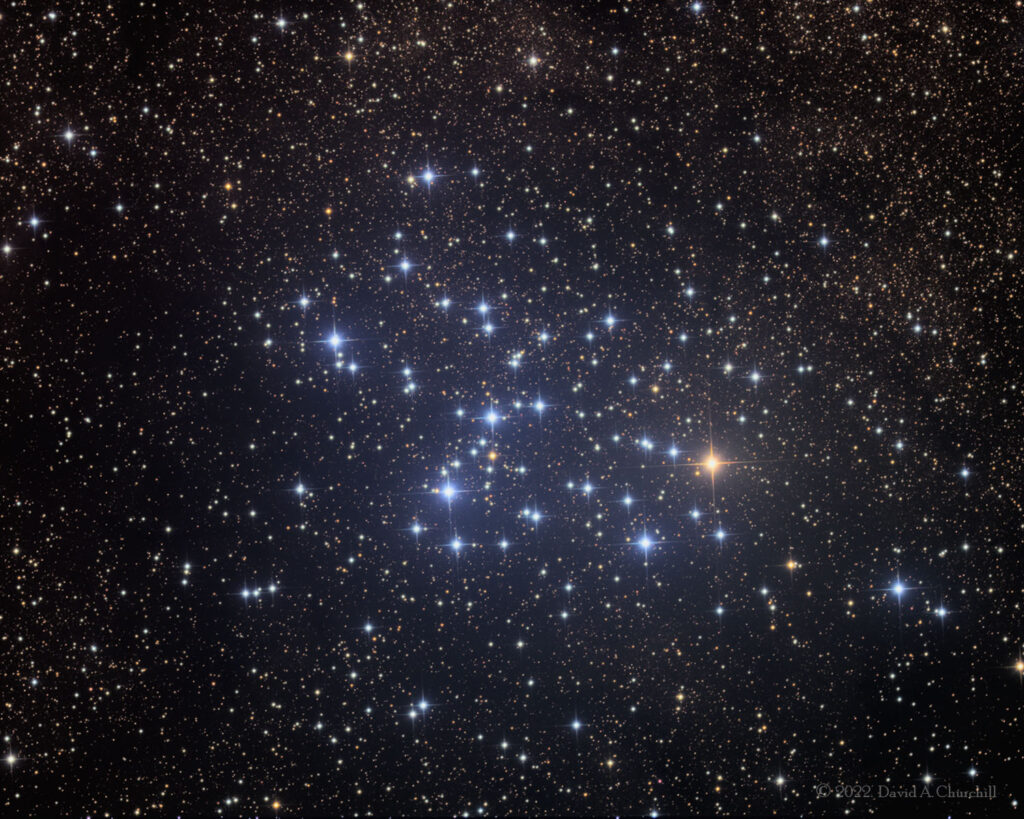Messier 6
The Butterfly Cluster. Open Cluster, Scorpius
- Description
- Technical
- Links
The Butterfly Cluster (cataloged as Messier 6 or M6, and as NGC 6405) is an open cluster of stars in the southern constellation of Scorpius. Its name derives from the vague resemblance of its shape to a butterfly. The Trumpler classification of II 3 r encodes it is rich in stars, ranks II out of IV for disparateness and greatly mixes bright with faint components. It is 3.5° to the northwest of Messier 7, both north of the tail of Scorpius.
The first astronomer to record the Butterfly Cluster’s existence was Giovanni Battista Hodierna in 1654. However, Robert Burnham Jr. has proposed that the 1st century astronomer Ptolemy may have seen it with the naked eye while observing its neighbor the Ptolemy Cluster (M7). Credit for the discovery is usually given to Jean-Philippe Loys de Chéseaux in 1746. Charles Messier observed the cluster on May 23, 1764 and added it to his Messier Catalog.
Estimates of the Butterfly Cluster’s distance have varied over the years. Wu et al. (2009) found a distance estimate of 1,590 light-years, giving it a spatial dimension of some 12 light years. Modern measurements show its total visual brightness to be magnitude 4.2. The cluster is estimated to be 94.2 million years old. Cluster members show a slightly higher abundance of elements heavier than helium compared to the Sun; what astronomers refer to as the metallicity.
120 stars, ranging down to visual magnitude 15.1, have been identified as most likely cluster members. Most of the bright stars in this cluster are hot, blue B-type stars but the brightest member is a K-type orange giant star, BM Scorpii, which contrasts sharply with its blue neighbours in photographs. BM Scorpii, is classed as a semiregular variable star, its brightness varying from magnitude +5.5 to magnitude +7.0. There are also eight candidate chemically peculiar stars. The cluster is located 24.59 ± 0.13 kly (7.54 ± 0.04 kpc) from the Galactic Center and is following an orbit through the Milky Way galaxy with a low eccentricity of 0.03 and an orbital period of 204.2 Myr. At present it is 23 ly (7 pc) below the galactic plane, and it will cross the plane every 29.4 Myr.
The first astronomer to record the Butterfly Cluster’s existence was Giovanni Battista Hodierna in 1654. However, Robert Burnham Jr. has proposed that the 1st century astronomer Ptolemy may have seen it with the naked eye while observing its neighbor the Ptolemy Cluster (M7). Credit for the discovery is usually given to Jean-Philippe Loys de Chéseaux in 1746. Charles Messier observed the cluster on May 23, 1764 and added it to his Messier Catalog.
Estimates of the Butterfly Cluster’s distance have varied over the years. Wu et al. (2009) found a distance estimate of 1,590 light-years, giving it a spatial dimension of some 12 light years. Modern measurements show its total visual brightness to be magnitude 4.2. The cluster is estimated to be 94.2 million years old. Cluster members show a slightly higher abundance of elements heavier than helium compared to the Sun; what astronomers refer to as the metallicity.
120 stars, ranging down to visual magnitude 15.1, have been identified as most likely cluster members. Most of the bright stars in this cluster are hot, blue B-type stars but the brightest member is a K-type orange giant star, BM Scorpii, which contrasts sharply with its blue neighbours in photographs. BM Scorpii, is classed as a semiregular variable star, its brightness varying from magnitude +5.5 to magnitude +7.0. There are also eight candidate chemically peculiar stars. The cluster is located 24.59 ± 0.13 kly (7.54 ± 0.04 kpc) from the Galactic Center and is following an orbit through the Milky Way galaxy with a low eccentricity of 0.03 and an orbital period of 204.2 Myr. At present it is 23 ly (7 pc) below the galactic plane, and it will cross the plane every 29.4 Myr.
Telescope: Planewave CDK17 (FR) f4.5
Mount: Astro Physics 1600GTO
Camera: QHY16200A/ Integral FW
Guider: Agena Starguide II / ZWO ASI178MM
Filters: Astronomik 36mm LRGB
L: 59×5 mins = 295 mins, R: 24×5 mins = 120 mins, G: 24×5 mins = 120 mins, B: 24×5 mins = 120 mins
Total Imaging Time: 10h 55m
Data Imaged remotely over 3 nights during August 2022.
Imaged from Observatorio El Sauce, Chile, in partnership with Fred Espenak.
Data acquisition & Processing by David Churchill.
None

